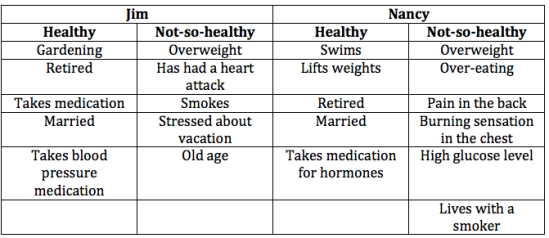In “The Healthy Retirement?” investigation, a married couple, Jim and Nancy, are in their sixties. While preparing for their BBQ cookout, Nancy tells her husband that she’s been feeling tired lately. Later that evening and after eating a lot of food, Nancy says that she’s been having back pains all week and now she has a burning sensation in the lower part of her chest. She takes medication, antacid, and the pain went away.
The next day, Jim and Nancy finish their packing for their cruise vacation. Nancy gets her test results that afternoon from an early morning screening, then they leave for their cruise. On the cruise, Jim and Nancy eat so much food, but they also plan to have morning and mid-afternoon power walks. They plan to increase their speed and distance each day. During the next morning on their power walk, Nancy experiences nausea and shortness of breath. On their group excursion, Nancy tells Carol, a member of the group, that the preparations for the trip wore her out. Carol then tells her that she’s been experiencing angina equivalent symptoms. She informs her to rest and to see a doctor who specializes in cardiology or internal medicine soon.
Here is a data table I’ve gathered from this investigation about Jim and Nancy and her test results:
Jim and Nancy have a few health issues and they are at risk for:
Jim – Lung disease because he smokes, heart attack, obesity, diabetes, and heart disease
Nancy – obesity, osteoporosis, diabetes, heart disease, heart attack, and emphysema
Some important information that might be helpful to know when assessing their health are family history, daily diet, any other medication they are taking, and past medical records.
According to Mayo Clinic, woman’s angina equivalent symptoms are different from classic angina symptoms. Some women experience angina equivalent symptoms that include nausea, shortness of breath, abdominal pain or extreme fatigue, with or without chest pain. Others experience symptoms that include discomfort in the neck, jaw or back or stabbing pain instead of the typical chest pressure. The symptoms of classic angina are chest pain, pain in arms, neck, jaw, shoulder/back, nausea, fatigue, shortness of breath, sweating, and dizziness. According to NHLBI, factors that cause these symptoms are smoking, high cholesterol, high blood pressure, and high glucose level. These factors also cause coronary heart disease (CHD).
The symptoms lessen when Nancy rests because her body is not working as hard as it was before. When she rests, she can regain her strength and energy. Before reading this case study, I did not know that males and females often have different symptoms for coronary heart disease or a heart attack. Medical researchers find out if individuals of both sexes and from diverse racial and ethnic backgrounds have similar symptoms or react the same to treatments by researching and conducting multiple experiments.


Dear Mia,
You present the case study very clearly and it is helpful that you included your data table. You use your data to clearly support your conclusions. Your post would be more engaging with some original media included, what do you think you could include? Looking forward to future posts!
Mrs. Kahn
LikeLike